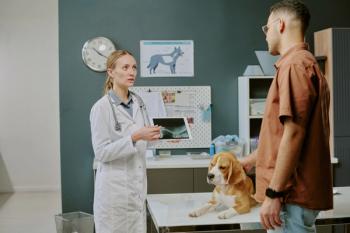
A practical parasite plan for pruritic patients (Sponsored by Pfizer Animal Health)
How parasites and parasite hypersensitivity cause pruritus and provides practitioners with tips to help improve diagnosis, treatment, and client interactions.
Many diseases can cause pruritus; however, a short list of five common conditions cause most clinical cases: atopic dermatitis, adverse food reaction, parasitism, pyoderma, and Malassezia dermatitis. Skin infectionswith bacteria and Malassezia are usually secondary to atopic dermatitis, adverse food reactions, or parasitism.
(IMAGE: GETTY IMAGES)
Therefore, veterinarians have two goals for pruritic patients: manage primary disease and eliminate secondary infections. This article focuses on how parasites and parasite hypersensitivity cause pruritus and provides the busy practitioner with tips to help improve diagnosis, treatment, and client interactions.
1. Perform parasite treatment trials to rule out occult parasitism.
Heavy parasite burdens cause direct damage to the skin inducing pruritus, excoriation, and infection. Identifying the causative parasite is not generally difficult in heavily parasitized patients. However, in many patients, clinical signs result from hypersensitivity reactions to small parasite burdens rather than direct damage. Hypersensitivity is most commonly associated with flea, Sarcoptes, Chey letiella , or Otodectes infestations. Classic distribution patterns for these parasites should trigger recognition; however, because patterns are variable, always consider occult parasitism, even if classic patterns are absent.
Make every effort to find parasites during the initial evaluation. This provides a definitive diagnosis, spares discussion of food trials and allergen testing, and improves client acceptance. However, failure to demonstrate parasites does not rule out parasite hypersensitivity. Treatment trials are easy diagnostic tests to eliminate the possibility of parasitism before pursuing more complicated testing for atopy or adverse food reactions. Failure to eliminate occult parasitism results in ongoing clinical disease and frustration. There is minimal risk and potential for maximal gain if parasites are the cause and are appropriately treated.
2. Prescribe safe and effective miticides for parasite treatment trials.
For parasite treatment trials, prescribe an effective miticide and reapply during the full life cycle of the parasite to ensure adequate treatment of all life stages. Because subclinical carrier animals can perpetuate low parasite burdens, all animals in the household must receive treatment at the same time as the affected animal, even if these animals show no signs of pruritus or parasitism.
Selamectin administered every two weeks for three treatments is a common protocol for Sarcoptes and Otodectes in dogs and cats. Off-label use of ivermectin at 200 to 600 ug/kg once weekly for four weeks is also widely used to treat canine Sarcoptes. Certain breeds commonly carry a gene mutation that increases the risk of neurotoxicity from ivermectin at this dosage. However, any individual dog of any breed can be ivermectin sensitive. Since consequences can be dire, all patients on high-dose ivermectin should be either tested for the multidrugresistance (MDR) 1 mutant gene or given lower doses first. If owners observe signs of neurotoxicity (ataxia, mydriasis, tremors, obtundation) at lower doses, discontinue therapy. Rather than risking a toxic event or using valuable consultation time discussing ivermectin toxicosis, the author recommends avoiding routine use of ivermectin for parasite treatment trials when there are safe, effective, and FDA approved alternatives readily available.
3. Relay to clients that comprehensive flea control is essential for all pruritic patients. Focus on prevention rather than treatment when talking to owners who may be reluctant to implement flea control.
In addition to miticidal therapy, institute aggressive flea control early in management of all pruritic patients, even if fleas cannot be demonstrated. Convincing clients to implement flea control can be challenging; however, you must deflect common objections and stress to owners that comprehensive flea control is in their best interest (see Table 1). You can improve compliance in this area by focusing on prevention rather than treatment. By doing this, you not only successfully convince owners to accept a treatment trial to rule out occult parasitism, but also establish the importance of ongoing flea prevention in managing of other causes of pruritus. Patients with atopic dermatitis are usually much worse with flea infestation, therefore ongoing flea prevention is an important part of an ideal management plan.
Veterinarians have many products available. Selection depends on each specific situation. For example, in atopic patients, if frequent bathing is recommended to manage secondary skin infections or reduce absorption of environmental allergens across the skin, use systemic flea products that cannot be washed off. Examples include selamectin, spinosad, and nitenpyram. Because of a short duration of action, nitenpyram should be repeated as often as one time daily or administered in combination with other products.
4. Perceived treatment failure is more likely due to newly emerged fleas than from resistance to the product.
Even when on-patient therapy is effective, owners may observe occasional adult fleas. This is usually due to newly emerged adult fleas from the environment rather than treatment failure or product resistance. True resistance is rare. Environmental flea burdens are heavier in multiple pet households or yards with feral flea carriers, such as possums or raccoons; this can result in ongoing exposure to newly emerged fleas for flea allergic pets. Therefore additional environmental control targeting all life stages becomes a necessary component of comprehensive flea control. If seeing a single live flea would cause owner to lose trust or perceive failure, adding a rapid kill adulticide, such as nitenpyram, spinosad, or dinotefuran may be desirable, in addition to environmental treatment.
To obtain the ideal of rapid kill, long duration, systemic distribution, and miticidal activity, combining multiple products, such as selemectin for safe and effective broad mite and flea management with dinotefuran, nitenpyram, or spinosad for rapid flea kill can be useful in certain circumstances. Consult the manufacturer for safety and compatibility with other products if combination therapy is necessary. ??
Table 1. Phrases to use with clients
Here are some examples of phrases to use with clients to emphasize the importance of prevention:
"Fleas probably aren't Skipper's problem; however, fleas still aren't his friend. His itch is severe already, imagine how much worse it would be if he got fleas too."
"We are doing this to figure out why Skipper is itchy. Getting flea bites in the middle of the food trial would really confuse the situation. Let's make sure that can't happen."
"Let's control what we can so we can narrow down the possibilities of what is making Skipper itch. We can't control pollen, but we can control fleas!"
"Usually people are bitten by newly hatched fleas. By the time you get bit, you have an infestation. It's much easier to prevent fleas now than to eliminate fleas later."
Newsletter
From exam room tips to practice management insights, get trusted veterinary news delivered straight to your inbox—subscribe to dvm360.




